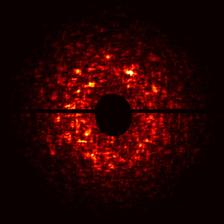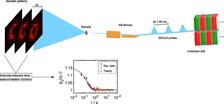Speckle pattern recorded at SACLA.
An international team led by DESY scientists has demonstrated the feasibility of studying dynamics of complex fluids at free-electron lasers via sequential-shot correlation spectroscopy. They performed a study on colloidal samples at the SACLA free-electron laser in Japan, which has been published in Scientific Reports, following an earlier study on slow dynamics performed at LCLS.
Hard X-ray free electron lasers (FELs) such as the LCLS at SLAC in Stanford (USA), SACLA in Japan and soon also the European XFEL allow for the first time to access dynamics of condensed matter systems ranging from femtoseconds to several hundred seconds. In particular, the exceptional high transverse coherence of the X-ray pulses and the high flux promises to reach time and length scales that have not been accessible up to now with storage ring based sources. However, due to the fluctuations originating from the stochastic nature of the self-amplified spontaneous emission (SASE) process the application of well-established techniques such as X-ray photon correlation spectroscopy (XPCS) has been challenged.
In XPCS experiments, sample dynamics are studied, typically at time scales between milliseconds and several 1000 seconds at storage-ring sources. At FELs, the accessible time scales are limited by the repetition rate of the pulses, i.e. about 10 to 50 ms at the currently existing hard X-ray sources LCLS and SACLA. With the start of the European XFEL, this will be routinely reduced to the sub-µs regime, not accessible at any FEL X-ray source up to now (Fig. 1). To study the feasibility of such experiments at the European XFEL, the impact of SASE fluctuations on XPCS experiments has to be understood at current FEL sources.
The researchers from the Coherent X-ray Scattering group of Gerhard Grübel at DESY, showed a single-shot based sequential XPCS study on a colloidal suspension. To perform such XPCS experiments, scattering patterns from at least two shots have to be compared. Thus, either the corresponding pulses or the sample have to be comparable in their characteristics. In their study, the research team led by Felix Lehmkühler, chose a well-defined and characterized sample system showing Brownian motion of several 100 nm large particles to compare the properties of the individual pulses with special attention to the application of XPCS. The short X-ray pulse duration at SACLA allows the recording of snapshot of the instantaneous sample structure expressed in speckle patterns. In sequential XPCS experiments, the sample structure is tracked over time by repeated recording of such speckle patterns. The sample dynamics is thus revealed by intensity correlation functions (schematics of the experiment in Fig. 2).
The researchers found that the shot-to-shot fluctuations are weak, e.g. less than 0.4 µm beam pointing fluctuations in the present experiment, showing that sequential X-ray photon correlation spectroscopy can be performed routinely at FEL sources. These results pave the way to XPCS experiments with access to timescales below microseconds at upcoming FEL facilities - such as the European XFEL.
(from Authors)
Reference:
“Sequential Single Shot X-ray Photon Correlation Spectroscopy at the SACLA Free Electron Laser”, F. Lehmkühler, P. Kwaśniewski, W. Roseker, B. Fischer, M. A. Schroer, K. Tono, T. Katayama, M. Sprung, M. Sikorski, S. Song, J. Glownia, M. Chollet, S. Nelson, A. Robert, C. Gutt, M. Yabashi, T. Ishikawa and G. Grübel, Scientific Reports 5, 17193 (2015). DOI: 10.1038/srep17193









